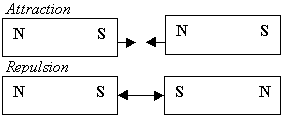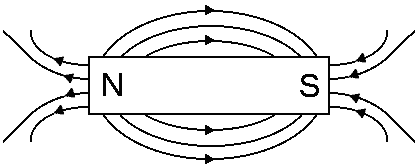
- Domain Theory of Magnetism
Magnets are made of iron, nickel or cobalt. In a magnet, there are groups of atoms called domains, each of which behaves like a tiny magnet.
In unmagnetised steel, the domains point in different directions and cancel one another out. In magnetised steel, the domains are pulled about until they point in the same direction, thus reinforcing each other.

- Properties of Magnets
- There are 2 ends or poles of the magnet (north and south)
- The north pole of a suspended magnet points north. The south pole of a suspended magnet points south.
- Unlike poles attract each other (e.g. north and south). Like poles repel each other (e.g. north and north, south and south).
- Magnets attract objects made of iron.
- Repulsion between a magnet and another object indicates that the other object is also a magnet.
- A magnet that is dropped or heated may lose its magnetism due to non-aligned or 'scrambled' domains.
- A magnetic field is the region around a magnet where lines of magnetic force point from north pole to south pole.


Magnetic Field of a Bar Magnet
- 4 Ways to Make a Magnet
- Stroke the magnetic material (e.g. screwdriver or metal ruler) with a bar magnet in the same direction
- Hold the magnetic material near a bar magnet for a long period of time
- Hold the magnetic material in a north-south direction, and strike it 30 or more times with a hammer
- Make an electromagnet by winding some plastic-coated wire around the magnetic material and connecting the wire to a battery